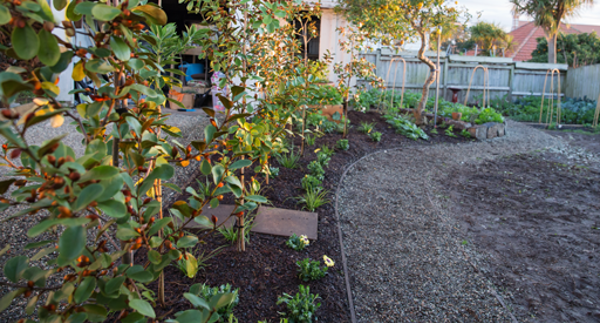
Create a garden full of flower and fragrance! If you've got an area along the edge of a drive, path or lawn, plant hardy but decorative flowering plants that work beautifully as a border and offer delightful fragrance. These plants give the perfect finishing touch and add definition to the space.
Shopping list:
- Tui Garden Mix
- Tui Compost
- Tui Organic Seaweed Plant Tonic
- Tui Mulch & Feed
- Tui NovaTec Premium fertiliser
- A selection of flowering border plants: Hymenosporum flavum (Australian frangipani tree), Hymenosporum flavum 'gold nugget' (Frangipani ground cover), Michelia gracipes, Osteospermum (African daisy), and Libertia Grandiflora.
Prepare
Like building a house a good foundation is the key to success in your garden. The better the soil, the better your plants will grow.
If you are starting with an existing garden bed dig in organic matter like Tui Compost and sheep pellets to replenish your soil. Then add a layer of Tui Garden Mix.
If you are creating a new garden bed, dig the area out and add Tui Garden Mix. Dig in plenty of compost to add nutrient-rich organic matter and break up heavy or clay soil.
Flowering border plant picks
1. Hymenosporum flavum (Australian frangipani tree)
This Australian evergreen native is renowned for its attractive fragrant flowers that are creamy yellow in colour. They also thrive in cooler areas if they are protected from frosts in the first couple of years.
2. Hymenosporum flavum 'gold nugget' (Frangipani ground cover)
This is a wonderful dwarf version of the Australian native with beautiful gold yellow flowers late spring to early summer. Also happy in patio pots if you’re short on space.
3. Michelia gracipes
Glossy leathery rounded foliage which always looks neat and tidy – they provide beautifully scented cream flowers early spring and are also good container growers. Can reach 4m x 3m at maturity.
4. Osteospermum (African daisy)
Unique buttery yellow blooms with a contrasting magenta eye smother this Osteospermum all summer. Loves a sunny position in the garden and a good prune so don’t be afraid to cut them back hard in spring. They are easy to grow and perfect on mass for a border feature and will give you an abundance of flower from mid-summer through to mid-autumn.
5. Libertia grandiflora (New Zealand Iris)
The largest growing of the New Zealand Irises. Libertia grandiflora has rich green foliage and tall stems of beautiful white star flowers produced in clusters in spring. They are a hardy plant that looks great in a mass planting or as a border plant.
Plant
The best times to plant are early in the morning or late in the day, so the plants aren’t exposed to the hot sun straight away.
Check individual planting instructions on plant labels and follow the recommendations for amount of space it needs, and whether it should be staked.
Directions for planting:
- Soak plants in Tui Organic Seaweed Plant Tonic before planting. This will help prevent transplant shock and promote strong root growth.
- Dig a hole, approximately twice the depth and width of the root ball of your plant. Partly fill with Tui Garden Mix (if you haven't already added a layer of Tui Garden Mix)
- Gently loosen the root ball of your plant.
- Position the plant in the centre of the hole. Fill in with Tui Garden Mix (if you haven't already added a layer of Tui Garden Mix).
- Press soil gently around the base of the plant.
- Water plants well.
Nourish
Replenishing nutrients used by your plants ensures they will grow to their full potential, improving flowering for prolific blooms to brighten your backyard. Use Tui NovaTec Premium fertiliser an all purpose compound fertiliser so your plants receive a balanced and even spread of all essential nutrients for maximum flowering.
Well watered, well nourished plants will have a better chance of keeping insect pests and diseases at bay.
Tui Tip
- Protect your trees from the elements with layers of mulch. Add a layer of Tui Mulch & Feed about 50mm deep around plants to suppress weeds and help conserve moisture. Be careful not to leave the mulch touching the trunk/stem of the plants as this can cause rot.
Post a comment
Flowering Border Garden Guide Comments
Be the first to write a comment